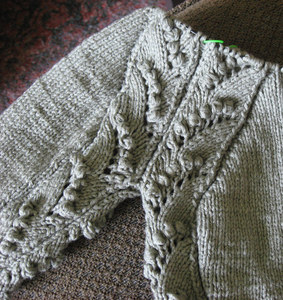S-s-something from the comments*
So, longer ago than I'd like to admit, Kristi asked me:
So of course I'm curious why you didn't leave the underarm space -- because it messed with the lace?
I think the space is less imperative on smaller sizes -- if you were doing a conventional shaped sleeve, your initial bind off would be about (chest - crossback)/2 on each side (this is assuming you're in the round) Or even less.
Plus, the lace is going to be more flexible/less bulky than stockinette and stretch or constrict as needed.
If you're thinking of sizing up the pattern though, I think the underarm shaping will begin to make a big difference.
Instead of writing her back (eek, sorry) I thought I'd post my response up here where y'all can see my reply because, man, she is just full of damn fine information.
The original concept of the piece was to work a lace, that had vertical symmetry, up the side of the piece, then split it off for the armsceye. The sleeve would be constructed the same way giving an uninterrupted path for the lace. The idea was that the lace would never appear to break even though it obviously had to split for the sleeves.
If I wanted to do a bind off at the underarms, I would have to gradually migrate the lace inward to be just inside the bind off point. This is possible but I really wanted to avoid disrupting the pattern.
With Kristi's great insight, I see that the combination of the stretchy Calmer and the small size make this possible. It does seem to work great for me so far. I have to seriously think how I'll approach the larger sizes (yes, I'm getting persuaded to actually write the pattern.) though.
If I do decide to write the pattern, I'll probably knit a partial second piece and do a gusset on one side and migration of the lace for a bind off, on the other to see which produces a nicer effect. I won't have to work a full chest circumference, just enough to be able to visualize the end result. Again, as Kristi pointed out, the lace will give some flexibility and the yarn is stretchy so I think I would have to do a relatively small amount of binding off even for a much larger size.
Talking to my dear friend, Julia, yesterday, I feel ready to tackle the neckline, which I've put on hold for a couple days while I contemplate. She suggested just a folded hem and I like that idea very much. I'm also considering something with eyelets that can be cinched in a little, to accommodate various undergarments. Either way, I want it to be relatively unobtrusive since there's already a lot going on with the lace. In the end, I think her hem idea is going to win out.
*Nod to Ze. I miss his show, The Show.

![[calpremiere.jpg]](https://blogger.googleusercontent.com/img/b/R29vZ2xl/AVvXsEiy0wh_95AcwniXEoBtZoHC2yUGJ2XuU8O_-D10FxvaeOSiaAAZM1J1JUHI-8zfGrMG6XFuO6WtsDA4bnq_jySFC87TnR_W_sP1M8F3Qm7KH-Rd4DMFp-C4FxTnvsq5uT1cptxd-XgQHng/s1600/calpremiere.jpg)
![[calpremieremove.gif]](https://blogger.googleusercontent.com/img/b/R29vZ2xl/AVvXsEjp5NGvZgOE3ghqG0Ksh0c6lFPEO_0hIHk4O2P5pWZ0wWdFS4L7lVQCH-6GkDPyynDaflFO1bc7V2YGCat9AKdSoPMgef2GrBPfe_b6l-llR-Ls7M-2KzYlwBBU_ehpWtIBFM6cdbKlA84/s1600/calpremieremove.gif)
6 comments:
I was actually just wondering the same thing today when I looked at your progress!
Glad you're moving along on the neckline, I can't wait to see the results.
Very interesting; thanks for the details on your thought process, and for recapping Kristi's comment.
I am curious about your design process for multiple sizes. Does it help to write a rough pattern first for multiple sizes? Or, do you find that you pretty much have to knit the garment first, and then write it for various sizes? I like the hem idea for the neckline.
Monica,
In the case of Lily, I had originally planned to knit it just for me but may decide later to size it. My size is not the "average" size so what I knit for me is usually not exactly what I write out for the pattern. Obviously, if I'm commissioned to write a pattern, the sample will be one of the standard sizes.
Often, I build a spreadsheet to calculate the various sizes as a part of the original design process. Sometimes, I just take careful notes of the sample and extrapolate later.
I guess the point is, it just depends :)
Thanks for the insight on your design process! Another design question...did you use a particualar software for your Lily graphics posted on the CAL? I am looking for a software to help with measurement schematics.
Monica,
I draw my own schematics in Adobe Illustrator.
I'm pretty sure that almost any knitting software will display schematics that you can use as a reference. I don't know how many will actually give you a publish worthy version that you can customize. I'm sure some do, but I am not sure which ones.
Post a Comment